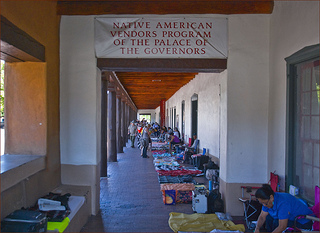 I recently returned from the Building Creative Communities Conference in Santa Fe, a gathering sponsored by New Mexico MainStreet, the New Mexico Historic Preservation Division, and New Mexico Arts. It was an extremely useful conference and I will be sharing thoughts about it come the New Year. For now, however, I wanted to mention an insight that came as a result of the pre-conference tourism in which my wife and I indulged. Several places we visited referred to New Mexico’s heritage as being a blend of three cultures: Spanish, Native American, and Anglo. Since last I spent any time in New Mexico (some 30 or more years ago) this recognition of Native culture as a co-equal root seemed refreshing and new.
I recently returned from the Building Creative Communities Conference in Santa Fe, a gathering sponsored by New Mexico MainStreet, the New Mexico Historic Preservation Division, and New Mexico Arts. It was an extremely useful conference and I will be sharing thoughts about it come the New Year. For now, however, I wanted to mention an insight that came as a result of the pre-conference tourism in which my wife and I indulged. Several places we visited referred to New Mexico’s heritage as being a blend of three cultures: Spanish, Native American, and Anglo. Since last I spent any time in New Mexico (some 30 or more years ago) this recognition of Native culture as a co-equal root seemed refreshing and new.
The more I thought about it, however, the curiouser I got. While I am by no means an expert in Native cultures, I know that they are profoundly dissimilar among themselves. Pueblo tribes have different languages, traditions, and histories; and the Athabascan native peoples–Navajo and Apache–are vastly different from pueblo communities as well as from each other. As I wrestled with this, I realized that Spanish and Anglo cultures are probably more closely related than many of the Native cultures. The division into three is extremely Eurocentric. It demonstrates a lack of awareness of the dissimilarities among native populations and an over-emphasis (in comparison) on the differences between the two European cultures. It would likely be more accurate to describe two (European and Native) or fifty, which would of course be a bit (!) cumbersome. For marketing purposes, I get the choice of three. It’s just that this raises an important issue for this blog.
Blindness to distinctions among unfamiliar cultures gets in the way of engagement. I have many times heard laments about the lack of awareness of dissimilarities among Hispanic/Latino cultures (South American and Central American countries, Caribbean nations, Mexico, not to mention Spain). Some friends have joked about efforts to “reach out” to Hispanics with Cinco de Mayo celebrations, demonstrating a lack of awareness that Cinco de Mayo is a Mexican celebration with no meaning for Hispanics from other countries.
Cultural myopia is a curable condition. In dealing with new communities, going in with an awareness that “we don’t know that we don’t know what we don’t know” is helpful. Expert guidance is essential.
——————–
As a gift to myself (and some might argue to you!) I am taking the next two weeks off to observe the Holidays. I wish you well: rest and celebrate as you need and desire.
Engage!
Doug
- Photo:
 Some rights reserved by Ron Cogswell
Some rights reserved by Ron Cogswell
